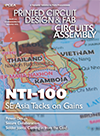News
HONG KONG -- Hong Kong-based Trans Global Logistics is advising air freight shippers to plan for an extra couple of days' transit time from Asia gateways beginning in mid-March. The reason? Air freight volumes - fueled by high-tech and electronics shipments - are aniticpated to surge as the "mini peak season" takes shape.
According to the company, recent canceled flights out of Hong Kong will add to a backlog of freight. And although air lift serving Shanghai has increased since last year, growing demand from shippers is creating a tight space situation. Carriers are expected to increase rates up to 25% this month.With business activity in India picking up, transit times are expected to be three to four days longer than last month. Carriers are generally only committing confirmed transit times for Express service.
Looking ahead, president Robert Mooney stated that another surge in the price fo crude oil may cause airlines to pass along these costs through higher fuel surchaces (FSC). Hong Kong carriers have already announced a return to $0.36/Kg FSC, effective March 22.
The company is now authorized to distribute all Foxconn brand products, including motherboards, chassis and coolers. The agreement covers all territories of ASBIS' current operation.
The partnership will promote the sales of Foxconn products throughout 26 countries with distribution centers located in Holland, the Czech Republic, United Arab Emirates and Finland. Foxconn will provide a three-year warranty for motherboards and two-year warranty for chassis, power supply, coolers and card readers.
Bumping helps in high-speed, high-power applications that need quick turn to validate design, and helps provide better test simulation prior to final design. When cycle time is important, cost is critical and resources are limited, bumping a few die at a time can be effective to evaluate a design.
The process is applicable to traditional or MEMS components, and bumps can be applied to a substrate or die. Bump-to-bump variability is reportedly reduced compared to other processes such as solder jetting, screen-printing or electroplating. The traditional prototype method of using gold studs followed by thermocompression or thermosonic bonding can be eliminated.
The company can also attach solder balls to bare Al bond pads. The same hardware can be used to bump a die with various alloys to evaluate lead-free solutions. Alternating pads on the die can be bumped with differing alloys or geometry, allowing electromigration studies within the same die or within one wafer. This also reduces lot-to-lot and wafer-to-wafer variation.
The process is said to eliminate variables such as paste viscosity, metal load changes, missing bumps, voiding, and changes in size and planarity.
CVI can accommodate individual die bumping, partial wafer bumping, or die repair with various alloy compositions. Contact Terence Collier for more information: tqcollier@covinc.com.
Press Releases
- Syrma SGS Technology, Ltd to Accelerate AI-Driven Manufacturing with implementation of analytics and AI solution from Arch Systems in partnership with NMTronics India
- TTCI and The Training Connection Strengthen Electronics Manufacturing with Test Services and Training at PCB West 2025
- SMTA “Members of Distinction” Awards Announced
- Yamaha reveals software innovations to boost printing, mounting, and intelligent factory


